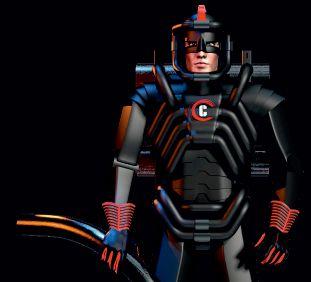


— Share your experience with our NEW products. FREE t-shirt! Hurry-up!
Offer valid for the first 150 Marrette eligible participants.






— Share your experience with our NEW products. FREE t-shirt! Hurry-up!
Offer valid for the first 150 Marrette eligible participants.



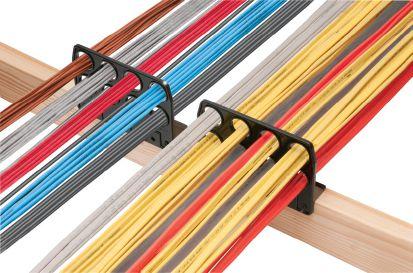

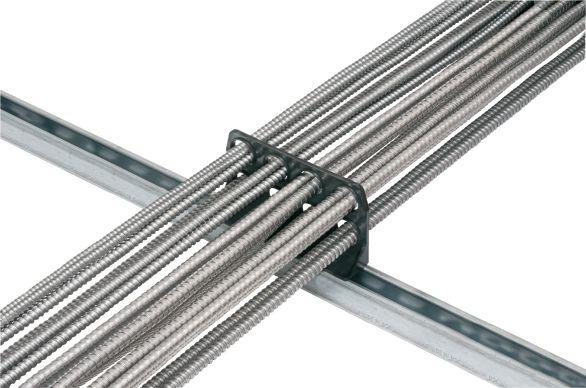

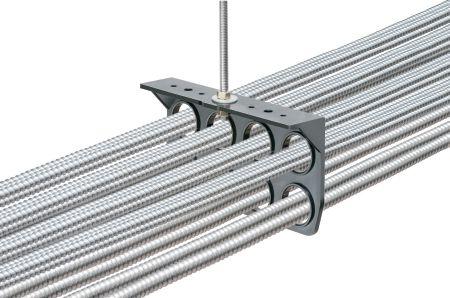





Perfect for commercial or residential applications, Arlington’s time-savingnon-metallic CableAble® Support Brackets are the ONE BRACKET designed for horizontal runs of cable or conduit, commercial or residential applications, power or low voltage wiring, and plenum* or non-plenum ceilings.
• Versatile four- and eight-hole L or T style Brackets mount horizontally or vertically to wood or steel studs, and unistrut, and horizontally to all thread and beam clamps
• Multiple mounting options, secure support for EMT or flexible metal conduit, power MC and NM cables, and low voltage cables


• Load Rated for various mounting options For Environmental Air Handling Spaces per NEC 300.22 (c) 1-1/4" holes ITEM




CA8 Eight T Bracket
CA8L Eight L Bracket CA4 Four T Bracket
CA4L Four L Bracket
All styles available in bulk 50 packs, add “X” suffix to any of the above listed item numbers



ANTHONY CAPKUN
Whether you’re involved with installing chargers, or planning and building out EV infrastructure, the regulatory shift stateside could very easily have a detrimental effect here in Canada.
A U.S. Senate joint resolution of disapproval seeks to repeal California’s “electric vehicle mandate” (a.k.a. “Advanced Clean Cars II” regulation), sending it to President Trump for signature. This measure would rescind a waiver that allowed that state to mandate that a certain share of new car sales meet zero-emission standards.
Once signed into law, the U.S. Environmental Protection Agency’s Office of the Administrator says it “will move expeditiously to [...] remove them from the books”.
This should come as no surprise to anyone in the zero-emission vehicle (ZEV) space, as Trump’s Executive Order “Unleashing American Energy” openly seeks:
(e) to eliminate the “electric vehicle (EV) mandate” and promote true consumer choice [...]
Like California, the Government of Canada also announced a mandatory target for all new light-duty car and passenger truck sales to be zero-emission vehicles (ZEVs) by 2035.
But with the EV pendulum swinging in the opposite direction in the U.S., what will become of Canada’s EV industry? Here are just a few concerning headlines:
• Honda postpones $15-billion EV investment project in Ontario citing market demand
• Northvolt’s Quebec battery plant status unclear due to bankruptcy
• Ford backs away from $1.2B battery materials plant in Quebec amid EV growing pains
Automaker pressures coupled with the scaling back of ZEV mandates will undoubtedly have an impact on which EV projects move forward, how incentives are structured, and so on. If you’re heavily involved in North America’s EV ecosystem, you’d better buckle up.
It’s going to be a bumpy ride.
acapkun@ebmag.com

company/electrical-business-network

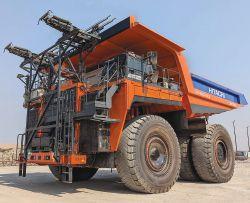

Built to store. Powered by partnership. Delivered ahead of schedule and under budget, the Oneida Energy Storage Project offers a blueprint for successful large-scale storage.
Mining takes a sustainable step forward
Hitachi commences feasibility trial of the world’s first ultra-large, full battery rigid-frame dump truck.
AI and high-density computing are accelerating data centre power needs
From Eaton’s “2025 Data Centre Progress Report” we highlight areas where electrical engineers and contractors can flex their expertise.
Ontario backs Meaford pumped storage project, despite alternatives
The government will spend up to $285M to advance work for the proposed project, despite the electricity system operator’s recommendation against it.
Out and About: Trades & Talent Summit
Support Ontario Youth’s inaugural 18+ career fair connects jobseekers with skilled trades employers.
COLUMNS
26 From the Legal Desk Legal implications of PoE technology
30 Code File Getting a grip on vertical conductor supports

ABB team members (from left): Carla Candish, marketing specialist, ELSP/ELSB; Maxim Blais, regional sales manager; Marc-Antoine Veillette, product manager; Catherine Chapleau, division leader, ABB Smart Power, Smart Buildings; Alexandre Santerre, supervisor, Research & Development; Leila Sedighi, vice-president, product and marketing; Joel MacPherson, marketing specialist, Events & Segments. More photos at EBMag.com, direct link: tinyurl.com/mwwajdcs SOURCE: ABB
One of the main attractions at the biennial MCEE Expo is the New Product Competition which, this year, attracted 87 products across eight categories. Congratulations to the following finalists and winners that apply to Canada’s electrical sector:
Software, controls and related components
• ABB ReliaHome smart panel (WINNER)
• Resideo – Honeywell Home T10+ Pro smart thermostat with RedLINK 3.0
• Sinopé Technologies Evolutive thermostat for baseboard heaters
Commercial, institutional, and industrial electrical products
• ABB Iberville gangable boxes for steel stud application
• Eaton Evolute smart load management panel (WINNER)
• I-Gard i-AVT Plus tester
Indoor and outdoor lighting
• CSC LED Flex FL05 flood/area light luminaire
• Ledalite ArcForm Duo light fixture (WINNER)
• Stonco Keene LytePro garage and canopy luminaire
Tools, machines, protective and other equipment
• FLIR CM276 clamp meter (WINNER)
• Multitel MTE 270 EX truck-mounted aerial work platform
• Navac Flex-X N2DX manifold gauge

The EM Honours Awards Program is your opportunity to gain national recognition and showcase leadership in energy efficiency, proactive energy management and decarbonization.
Anyone involved in a project or solution is eligible to nominate.
In the electrical space, past honorees include Cence Power, Ledvance, and Variablegrid.
Among the award categories, you will find:
• Best Electrical Solution
• Best Retrofit Project
• Best Software Solution (new!)
• Best New-Build Project Honorees will be announced in October during a special presentation hosted by Energy Manager Canada. Nominations are completed online at energy-manager.ca/awards. The deadline to nominate is August 29,
Reader Service
Print and digital subscription enquiries or changes, please contact Customer Service: Angelita Potal Tel: 416-510-5113
Fax: (416) 510-6875
email: apotal@annexbusinessmedia.com
Mail: 111 Gordon Baker Rd., Suite 400 Toronto, ON M2H 3R1
Editor-Publisher Anthony Capkun acapkun@ebmag.com
Brand Sales Manager Leslie Osborne losborne@annexbusinessmedia.com
Media Designer Svetlana Avrutin savrutin@annexbusinessmedia.com
Account Coordinator Catherine Giles cgiles@annexbusinessmedia.com
Group Publisher Danielle Labrie dlabrie@annexbusinessmedia.com
Audience Development Manager Urszula Grzyb ugrzyb@annexbusinessmedia.com 416-510-5180
CEO Scott Jamieson sjamieson@annexbusinessmedia.com
Published by Annex Business Media 111 Gordon Baker Road, Suite 400 Toronto, ON M2H 3R1 Tel. 416-442-5600
ELECTRICAL BUSINESS is the #1 Canadian resource for electrical contractors, maintenance and engineering professionals, distributors, manufacturers and their agents and associated stakeholders.
PRINTED IN CANADA ISSN 0013-4244
Publication Mail Agreement #40065710
Subscription rates
Canada: $38.76 (per year)
Canada: $9.00 (single issue)
USA: $88.23 (CAD per year)
Foreign: $106.08 (CAD per year)
Annex Privacy Officer Email: privacy@annexbusinessmedia.com Tel: 800-668-2374
Occasionally, Electrical Business will mail information on behalf of industry related groups whose products and services we believe may be of interest to you. If you prefer not to receive this information, please contact our Customer Service department in any of the four ways listed above.
The contents of Electrical Business are copyright ©2025 by Annex Business Media and may not be reproduced in whole or part without written consent. Annex Business Media disclaims any warranty as to the accuracy, completeness or currency of the contents of this publication and disclaims all liability in respect of the results of any action taken or not taken in reliance upon information in this publication.
We acknowledge the [financial] support of the Government of Canada



Mott Electric Pavilion at BCIT “will benefit generations of trades professionals”
The British Columbia Institute of Technology (BCIT) celebrated the naming of a new purpose-built space that will feature hands-on training and skills development in the areas of renewable energy, robotics, and automated controls.
The Mott Electric Pavilion at the BCIT Burnaby Campus is made possible by a $2-million donation from Mott Electric, and its president, Dan Mott, a BCIT Electrical Apprenticeship alumnus.
“[This] is a full circle moment to give back and help transform the very place that I once trained at as a young electrical apprentice,” said Mott. “I feel extremely proud to support future trades students and hope the expansion of the pavilion will benefit and prepare future trades professionals in the province and in our communities.”
Founded in 1930, Mott is one of the oldest and largest electrical contracting companies in the Lower Mainland.
The new pavilion will help expand access to electrical apprenticeship training opportunities; in fact, BCIT says its Electrical Trades program is the largest such program at the institute, with approximately 2,000 students enrolled annually and an extended waitlist.
Technical Safety BC’s 2024 State of Safety report emphasizes escalating concerns around the grey market of unlicensed, uncertified, and unpermitted work, as well as the “false economy” of cost-cutting at the expense of safety.
The grey market of unlicensed, uncertified, and unpermitted work poses a significant safety risk in British Columbia, says the agency. In 2024, Technical Safety BC conducted over 1200 investigations into suspected grey market activities. Key findings of non-compliance in gas and electrical technologies included:
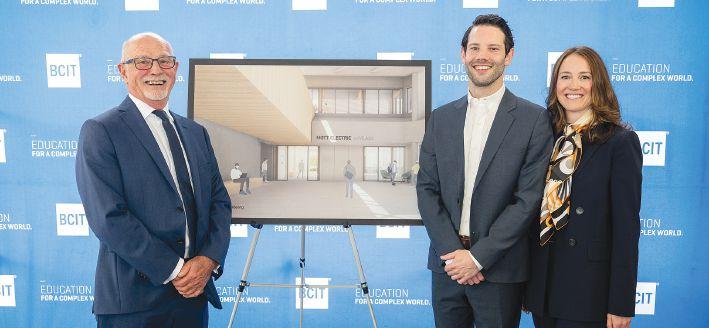
• using expired licences
• performing work outside licensed technologies
• obtaining permits for unlicensed or unqualified individuals
• working without proper permits
• advertising regulated work without required licences
The safety report also notes some individuals and organizations are making decisions that prioritize cost-cutting over long-term safety. For example, using low-quality materials that fail to meet safety standards, skipping safety training, and overextending equipment.
Additionally, Technical Safety BC found over one thousand electrical permits to have the incorrect job value, amperage, or installations listed, requiring permit value amendments.
EV adoption, survey finds

In a recently published EV charger survey commissioned by Fluke, 36% of respondents identify charger maintenance as a top concern for the future of the industry.
Adding to the complexity, 44% pointed to inoperable chargers as one of the biggest hurdles facing EV charging infrastructure, followed closely software incompatibility (40%).
Compounding these challenges, 88% of respondents highlighted a critical skills gap within the EV workforce, signalling an urgent need for training and development to support the industry’s growth.
Fluke says the survey underscores its call for proactive maintenance strategies and workforce development to meet the growing demand for reliable charging infrastructure.
Respondents identified predictive maintenance (32%) and artificial intelligence (31%) as contributing to a successful EV charging strategy.
Resilient infrastructure design, remote monitoring and diagnostics, and the adoption of standardized best practices were also identified as vital for ensuring the reliability, efficiency, and adaptability of the EV charging ecosystem.
A space program that never leaves Earth? That’s the clever international marketing campaign by bearing manufacturer SKF to describe its partnership with Minesto, whose energy kites harness the “Moon’s energy” by leveraging the power of the tides.
Over the past year, the partners have been pioneering predictable tidal
energy using these kites in waters off the Faroe Islands. An autonomous Danish territory, the islands are located in the North Atlantic, roughly halfway between Norway and Iceland.
The tidal kite “Luna” has a rated power of 1.2 MW, enough to power 200 homes with electricity for one year. The next goal is to implement a new 200-MW tidal energy facility. This could meet 40% of the expected electricity needs in 2030, providing renewable electricity to the remote island nation’s 50,000 people and 70,000 sheep.
“We estimate there are at least 3,000 more ‘Faroe Islands’ out there qualifying for our space program; if they all join, moon energy could replace all coal power capacity currently under development globally,” said Minesto CEO Martin Edlund.

SaskPower has selected Potentia Renewables Inc. and its Indigenous partners—Meadow Lake Tribal Council (MLTC) and Mistawasis Nehiyawak First Nation—to develop, own, and operate a new wind and a new solar facility in south-central Saskatchewan.
The 200-MW Rose Valley wind project is located about 30 kilometres southeast of Assiniboia in the Rural Municipality of Excel No.71, and occupies approximately 22,000 acres of private land. The project will involve 28 Goldwind turbines with a 110-m hub height, underground collector lines, padmount transformers, new substation and main transformer, and related infrastructure.
The 100-MW Southern Springs solar project sits on 510 acres of privately owned, cultivated land approximately
8 kilometres southeast of the Town of Coronach. The project will consist of 207,000 ground-mounted bifacial solar PV modules on single-axis trackers, 27 inverter stations/transformer stations, internal access roads, underground collector lines, and a step-up transformer station.
M-Squared (M2) Renewables—a partnership between MLTC and Mistawasis—will own 51% of each project, which will be the largest Indigenous ownership to-date for projects of this size in the province.
ABB Electrification Canada Inc. has acquired Bel Products Inc., a Canadian manufacturer of custom-built enclosures, housings, panels and accessories, serving sectors such as commercial, industrial, data centre, and utilities.
“The acquisition of Bel Products complements our electrical offerings and strengthens our ability to deliver locally manufactured solutions,” said Mike Shenouda, Canada Region Leader and GM, ABB Installation Products.
Founded in 1964 and headquartered in Montreal, Bel will continue operating from its current manufacturing facility and warehouse in Terrebonne, Que.
“Joining ABB marks a new chapter for Bel Products,” said president Réal Bélanger. “ABB’s reputation and global reach open new opportunities for us, and we are excited to extend our capabilities and serve a broader range of customers.”
Congratulations to the companies that have joined the ranks of Deloitte’s Canada Best Managed Companies (2025), or have maintained their Best Managed, Gold, or Platinum status.
As usual, we focus on companies carrying out electrical work, or serving those who do:
Best Managed (New): Blais Industries, Smith & Long, T&T Power Group.
Best Managed: Franklin Empire (moves up from “New”), Six Nations of the Grand River Development Corp.
Gold Standard: Innovair Solutions (moves up from “Best Managed”), Magna IV Engineering.
Platinum Club: Alliance Energy, Deca Cables, EB Horsman & Son, Eddy Group (moves up from “Gold”), ECS Electrical Cable Supply, Gerrie Electric Wholesale, Groupe Deschênes (includes Daltco Electric, Ideal Supply, Powrmatic), Houle Electric, K-Line Group of Companies, Lakeside Process Controls, Laurentide Controls, Mircom Group, Modern Niagara, PTI Transformers, Rex Power Magnetics, Robinson Supply, Stanpro, Stelpro.
The Canada Best Managed program celebrates the top privately owned Canadian companies with annual revenues over $50 million, which are evaluated on leadership in the areas of strategy, capabilities and innovation, culture and commitment, and governance and financials.
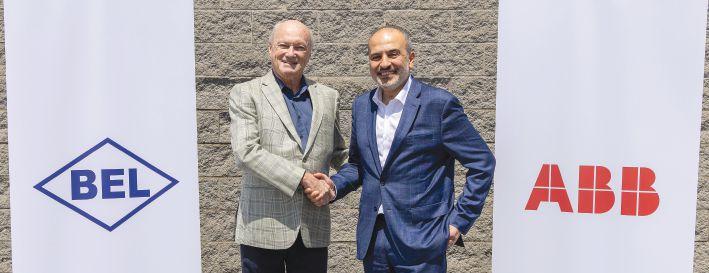
Support Ontario Youth is the proud recipient of $25,000 courtesy of Ideal Canada on behalf of the Ideal Foundation, which will allow SOY and Tools in the Trades (a SOY initiative) to expand their ability to deliver resources to those interested in a career in the skilled trades, explained Sean Bernard, national sales manager–Canada, Ideal Electrical.
“SOY has been an incredible partner over the years and is providing a necessary service to enhance the awareness of skilled trades as a profession,” Bernard continued. “I am very pleased that—with the commitment of the Ideal Foundation—we have been able to strengthen our commitment with SOY and continue to grow our brand within the skilled trades community.”
Manitoba Hydro and the Manitoba Home Builders’ Association (MHBA) are working to accelerate the energization of new homes, with the utility energizing new homes within five days of passing final electrical and gas inspections.
Other changes in the works include Manitoba Hydro and the MHBA implementing enhanced early servicing of new home sites. This involves the utility installing the basic electric and natural gas infrastructure much earlier in the construction process so it can be energized more quickly after inspections.
These changes are being initially rolled out in Winnipeg, Selkirk, and Steinbach.
Another change will give Manitoba Hydro inspectors, advisors, and MHBA members access to a new online portal for scheduling service installations, ensuring building sites are ready to receive service, and checking the status of service requests and inspections.

Following approval from the Superior Court of Quebec, a group of investors has acquired the company formerly known as “Lion Electric”. Headquartered in St. Jerome, the company sought creditor protection in December 2024 and had since been seeking a buyer.
The new ownership brings together investor-entrepreneurs Pierre Wilkie, Luc Sabbatini, Éric D’Anjou, Claude Boivin, Martin Barbeau, Pierre Bolduc and Michael Zakuta, as well as Mach Capital (Vincent Chiara).
The owners of the new company “LION” plan to streamline operations by focusing exclusively on electric school buses, assembled locally for the Quebec market.
Google has announced support for workforce development in the electrical sector by backing the Electrical Training Alliance (etA)—a joint initiative of the U.S.-based National

Electrical Contractors Association and IBEW.
The support will help enhance training for more than 100,000 electrical workers and 30,000 new apprentices across the United States.
This news comes on the heels of a new paper published by Google “Powering a new era of American innovation”, in which authors Ruth Porat, Thomas Kurian, James Manyika, and Kent Walker write:
[...] a shortage of electricians may constrain America’s ability to build the infrastructure needed to support AI, advanced manufacturing, and a shift to clean-energy. McKinsey estimates that 130,000 additional electricians will be needed by 2030 to build out data centers and manufacturing facilities in the coming years. But we’re going in the wrong direction: Nearly 10,000 American electricians either retire or change careers each year while only about 7,000 new entrants join the field.
“With funding from Google.org [...] etA will integrate AI tools into its curriculum and boost the number of apprentices nationally. It will also provide apprentices with access to Google’s AI Essentials course to master AI skills,” said Ruth Porat (photo, left), Alphabet and Google’s president & chief investment officer.
With the goal of bringing together industry leaders, innovators, and stakeholders to address the construction sector’s challenges, Pitt Meadows Plumbing & Mechanical Systems Ltd. partnered again with Houle Electric to deliver “Future of Work 2025”—a conference focused on collaboration and industry evolution.
“We built [this event] because construction deserves a conversation that is grounded in experience, elevated by innovation, and led by the people doing the work,” said Houle’s Matt Bewsey.
Held at Pitt’s facility in Maple Ridge, B.C., the two-day event included an Industry Mixer to encourage networking among project owners, general contractors, trades, and innovators, followed by a full day of panels and keynotes, which tackled themes such as collaborative project



Ledvance reports that the U.S. Patent Trial and Appeal Board (PTAB) has instituted an Inter Partes Review (IPR) proceeding against Feit Electric Co. Inc.’s white filament LED patent.
The PTAB’s decision, says Ledvance, acknowledges “a reasonable likelihood” that the claims asserted by Feit under a patent infringement action are not patentable.
A final ruling is expected within a year, Ledvance says, adding that it is “confident” of a favourable outcome”.
delivery models, technology integration, workforce development and reshaping public perception of the trades.
Attendees were invited to donate gently used PPE, which would be provided to the Working Gear Clothing Society to help equip individuals entering the skilled trades.
Siemens will invest $150 million over five years to establish a global AI manufacturing technologies R&D centre for battery production in Canada.
The new centre will be located initially at Siemens Canada’s head office

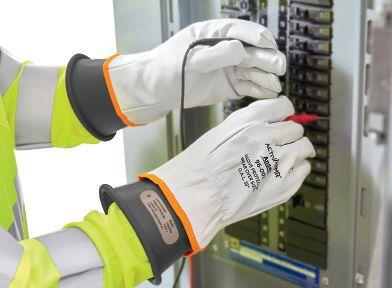

in Oakville, Ont., as well as in Toronto and Kitchener-Waterloo, Ont. It will focus on developing AI manufacturing technologies with an initial emphasis on battery and electric vehicle (EV) production.
The Siemens R&D centre is also receiving support from governments of Canada and Ontario.
Alectra Utilities announced a commitment to prioritizing Canadian businesses, suppliers, and vendors through its procurement processes for equipment and services.
“By sourcing Canadian whenever possible, Alectra Utilities is reinforcing its commitment to helping build a resilient supply chain while continuing to deliver safe, reliable, and affordable electricity to our customers,” said president & CEO Brian Bentz.
The municipally owned electricity utility serves about 1.1 million homes and businesses in Ontario’s Greater Golden Horseshoe area.
Gescan has signed a distribution partnership with ABB Motion—a business of ABB Ltd.—whereby the distributor will now offer ABB drive solutions in Manitoba and Saskatchewan.
“By leveraging our comprehensive
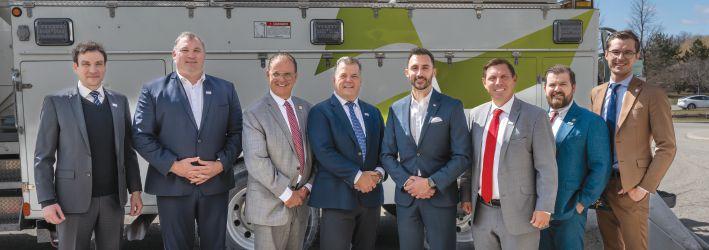
SOURCE:
portfolio, we are expecting this partnership will underscore the value and reliability of our offerings to our customers,” said ABB Canada drives division manager Benjamin Vadnais.
Leviton’s Network Solutions business has completed a $25-million expansion project at its Fuquay-Varina manufacturing facility, effectively doubling its size.
“We expect the demand for fiber optic cabling systems to grow for many years to support bandwidth-intensive applications like AI and augmented reality,” said president & CEO Daryoush Larizadeh.
The Fuquay-Varina site manufactures a range of multimode and single-mode cabling products used


& CEO Daryoush Larizadeh; COO Network Solutions and chief sustainability officer Ross Goldman.
SOURCE: SUPPLIED
to connect local area networks in applications such as commercial, data centre, and industrial.
NVent Electric plc is acquiring the enclosures, switchgear, and bus systems businesses of Avail Infrastructure Solutions for a purchase price of $975 million.
The business has about 1,100 employees and nine manufacturing locations. Upon closing, NVent plans to operate the group predominantly within its Systems Protection (formerly Enclosures) business segment.
We’re limited by space here, but have plenty of room online! Read the news behind the news. Visit EBMag.com and click “News”.
Ideal for construction and industrial electrician apprentices, students, trade qualifiers, and challengers
Aligned with the major work activities, tasks, and sub-tasks of the RSOS
Practice questions with answers to check and reinforce your knowledge
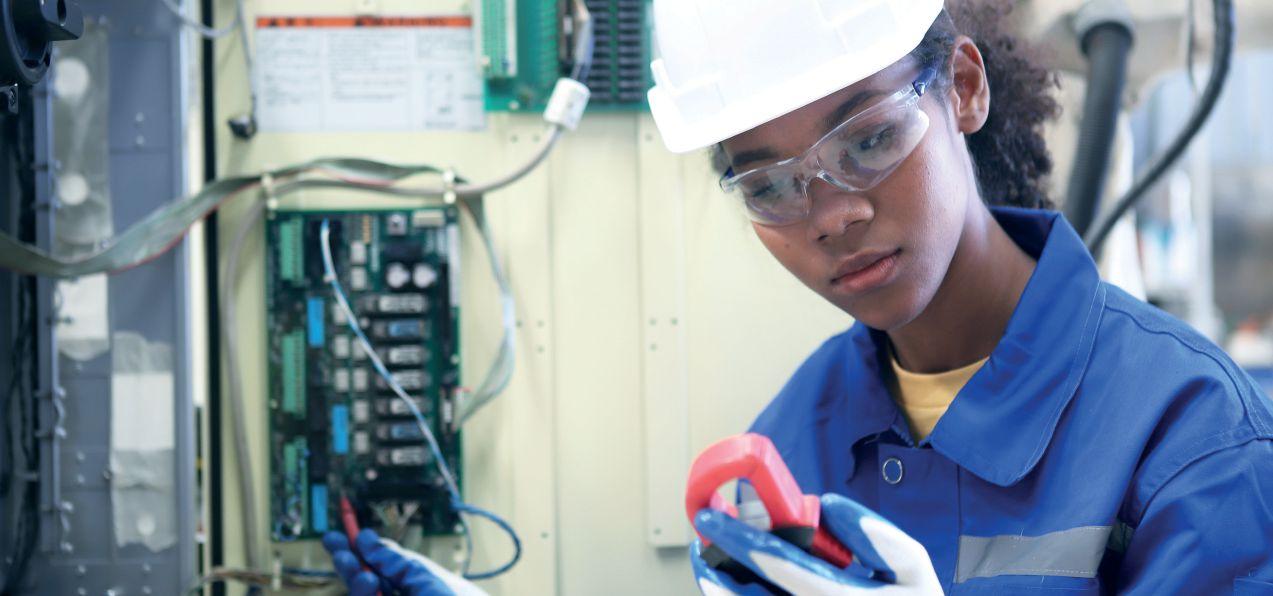
The Canadian Electrical Trade Study Guide helps you prepare for the trade certification exam
Are you planning to take the Construction Electrician Red Seal Exam to demonstrate your knowledge and skills in your trade? CSA Group’s Canadian Electrical Trade Study Guide can help strengthen your understanding of electrical systems, refresh your knowledge, and gain confidence before taking the exam.
Why should you use the guide?
Developed by electrical professionals from across the country, the guide provides:
• an overview of the 2024 Canadian Electrical Code, Part I (CE Code)
• requirements of other relevant CSA standards
• diagrams illustrating the key CE Code concepts
• explanations of concepts covered in the Red Seal Occupational Standard (RSOS)
• step-by-step examples of calculations included in the CE Code
• practice questions with answers to check and reinforce your knowledge
• additional resources for electrical trades journeypersons

Get the Canadian Electrical Trade Study Guide
csagroup.org/CETSG

BY ANTHONY CAPKUN
With 278 lithium-ion battery units—each weighing more than 84,000 lb—now drawing and storing power from Ontario’s electricity grid, the Oneida Energy Storage Project has officially entered commercial operation, becoming the largest battery energy storage facility in operation in Canada, and among the largest globally.
Located in Haldimand County, Ontario, the 250-MW/1000MWh facility was delivered through a collaborative partnership between majority owner Northland Power Inc., Six Nations of the Grand River Development Corp. (SNGRDC), NRStor Inc., Aecon Concessions, and the Mississaugas of the Credit Business Corp. (MCBC). Together, these partners form Oneida Energy Storage LP.
Northland owns approximately 70% of the Oneida project, with the remaining ownership held by SNGRDC, NRStor, Aecon, and MCBC. The project was completed two months ahead of schedule for about $100 million less than the initial $800M estimate—even though the cost of lithium ion increased three times (once by 600%).
Originally developed under a 50/50 partnership between SNGRDC and NRStor Inc., the
project also received significant funding from Natural Resources Canada and the Canada Infrastructure Bank.
The project generated more than 180 jobs during peak construction—with a workforce that included over 40 Aecon-Six Nations employees.
“One of the things that I’m really proud of with this project is that it was delivered safely: 300,000 hours of effort and zero incidents. That is something I’m super proud of, and that commitment to safety is something we look for in every company we work with, and in every person that works on our projects,” says Northland Power president & CEO Christine Healy. “It’s non-negotiable for us and, I would say, for any credible developer.”
Partnerships make it happen
NRStor planted the Oneida project seeds several years ago, explains chair and CEO Annette Verschuren, which then took six years to develop and less than two years to build. She values the experience of having worked with the Six Nations community; learning what was important to them and finding ways they could benefit with equity in this project.
The next step for NRStor was to engage the Canada Infrastructure Bank, who was pleased
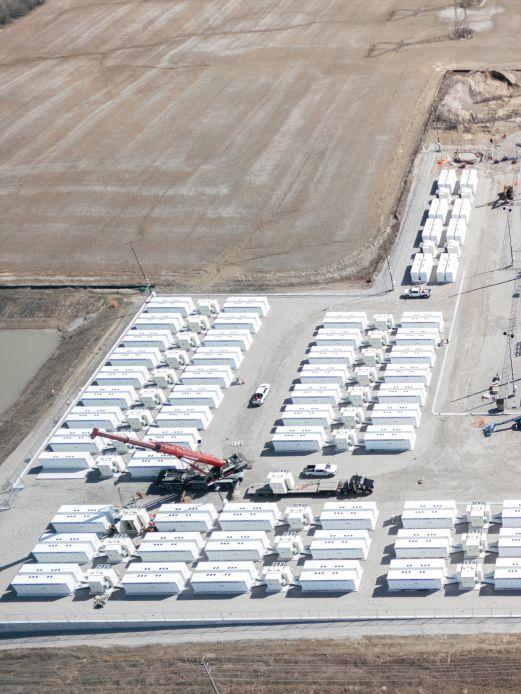

Christine Healy Northland Power President & CEO SOURCE: NORTHLAND POWER
“To take an idea and turn it into something real—that’s on the grid right now delivering energy solutions—is a big deal.”
to be working on their first energy sector project with a First Nation equity partnership.
“Then we went through the another great moment when presented a 250-MW project to the [Independent Electricity System Operator]. And I think we blew them away!” Annette laughs. “And we did it together: our NRStor team and the Six Nations team, led by Matt Jamison.”
And all of it during Covid. But additional partners were needed for the storage project. Aecon became a partner early on, says Annette, as they could “help design and build this project with us from an EPC perspective.”
Northland Power came on board as the major equity investor. Christine Healy, president & CEO, recounts that period:
“We spoke with Annette and NRStor, and the Six Nations of the Grand River; they had an idea for a first-of-its-kind battery storage project in Canada. They found a great location to do it, and they had a great concept. And then they went looking for some partners who could help them make it happen. And I’m really happy that Northland Power


Annette Verschuren NRStor Chair & CEO
SOURCE: NRSTOR
“This is like a poster child of how a project should be done.”
could be one of those partners.”
Annette could not have been more pleased. “We couldn’t have done it without Northland. They’re great executors of projects, with a great ability to get things done.”
The Mississaugas of the Credit First Nation then also joined the Oneida project, making this endeavour, according to Christine, “a story of partnership and a shared vision, and then persevering to make it happen.”
“Our partnerships-first approach to energy projects with Indigenous peoples really enabled the Oneida vision to become a reality and also resulted in a true Canadian success story, which serves as the model to replicate moving forward,” says Annette.
“It takes a lot to come up with an idea like this, but then also to figure out how to turn it into reality. There are many, many great

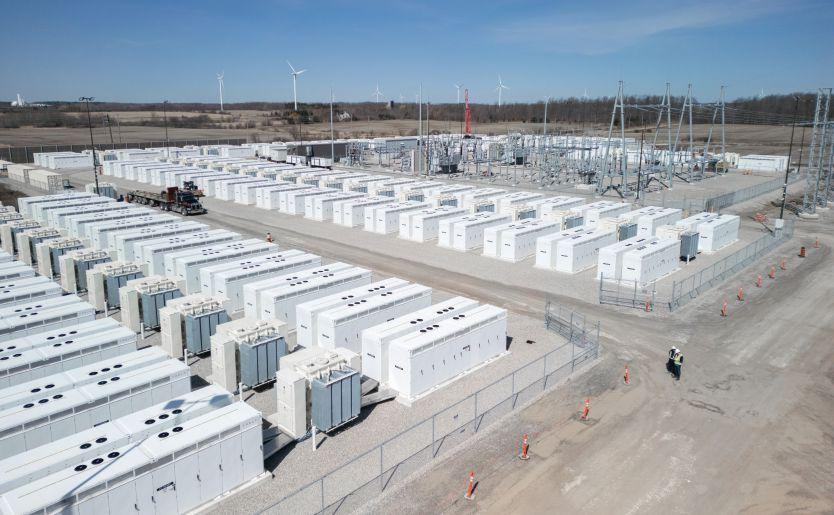
Each of Oneida’s battery units can deliver four hours of power—enough to supply a city the size of Oshawa for an hour.
ideas that never see the light of day,” Christine says. “So to take an idea and turn it into something real—that’s on the grid right now delivering energy solutions as we speak—it’s a big deal. And to do the first one is an even bigger deal... and we’ve done it safely.”
Annette recalls the regulatory hurdles they had to overcome: “There was no such thing as energy storage regulations. Was it a generator? Was it a load? It wasn’t either, right? And so we had to work with the Ontario Energy Board and with the IESO to help them understand what this facility could do.”
When she was president of Home Depot Canada, Annette oversaw the opening of 160 stores across the country. How did Oneida compare? “This was tougher,” she says.
“The reason this project was so successful is because of the great partners that we had,” Annette affirms. “It’s having the patience, developing the plan and executing superbly, and making it right as you go along. This is like a poster child of how a project should be done.”
Both Annette and Christine believe Oneida’s success creates a
strong template for future battery energy projects to follow because, as Christine notes, “there’s already a path cut through the snow.”
“And I think it will be easier [for future installations] to do that when they can point to one that’s already been done.”
Oneida LP will receive fixed capacity payments through a 20year capacity services contract with IESO and generate revenue from energy sold into the grid, as well as from providing ancillary services to the system.
The storage facility enhances the province’s grid by adding capacity and reliability to support the rising demand for energy, and doubling the amount of energy storage resources from 225 MW to 475 MW.
Each of those 278 battery packs is capable of a 4-hour discharge, which is enough to power a city the size of Oshawa, Ont., for an hour. The installation is expected to support grid reliability and reduce emissions by an estimated 1.2 to 4.1 million tonnes over the life of the project.
Annette is convinced that Oneida and similar battery energy storage installations are just the tip of the iceberg, and we are on the verge of massive sea change—not dis-
similar to the transformation of corded power tools she witnessed while at Home Depot Canada.
“When I started, everything was plugged in. Then, two years into my tenure, these great big clunky batteries started to be put on power tools,” Annette recalls. “Oh, and they were awful! They were heavy and the contractors were complaining [...] but I saw what was happening with lithium ion. Over 10 years, I saw all the power equipment move from plug-in to battery.”
With energy storage, Annette would like to see an even faster transformation. “We have to go faster. We really do, because despite all the things that are happening south of the border, companies are still looking for clean energy. That’s not going to go away. And Canada has the most clean energy in all of the world,” Annette says.
Christine agrees: the future is loaded with potential. She advises newcomers to seize any opportunity to join a project, because “nothing beats learning by doing”.
“We see the need and the demand for energy storage projects everywhere. It provides technical solutions, it provides shaping, and it responds to peak demand. Those things all fundamentally lead to a more stable grid, and they should lead to better energy prices for all of us as consumers,” Christine adds.
According to Christine, fewer than 10% of large-scale capex projects over $100 million around the world get delivered on time and on budget.
“And Oneida—the first of its kind in Canada and fourth largest in the world—was delivered ahead of schedule and under budget... and with an excellent safety record! I cannot tell you how proud I am and how happy I am to be a part of that.”
Perhaps Annette sums it up best: “Energy storage is like bacon: it tastes good and goes with everything.”
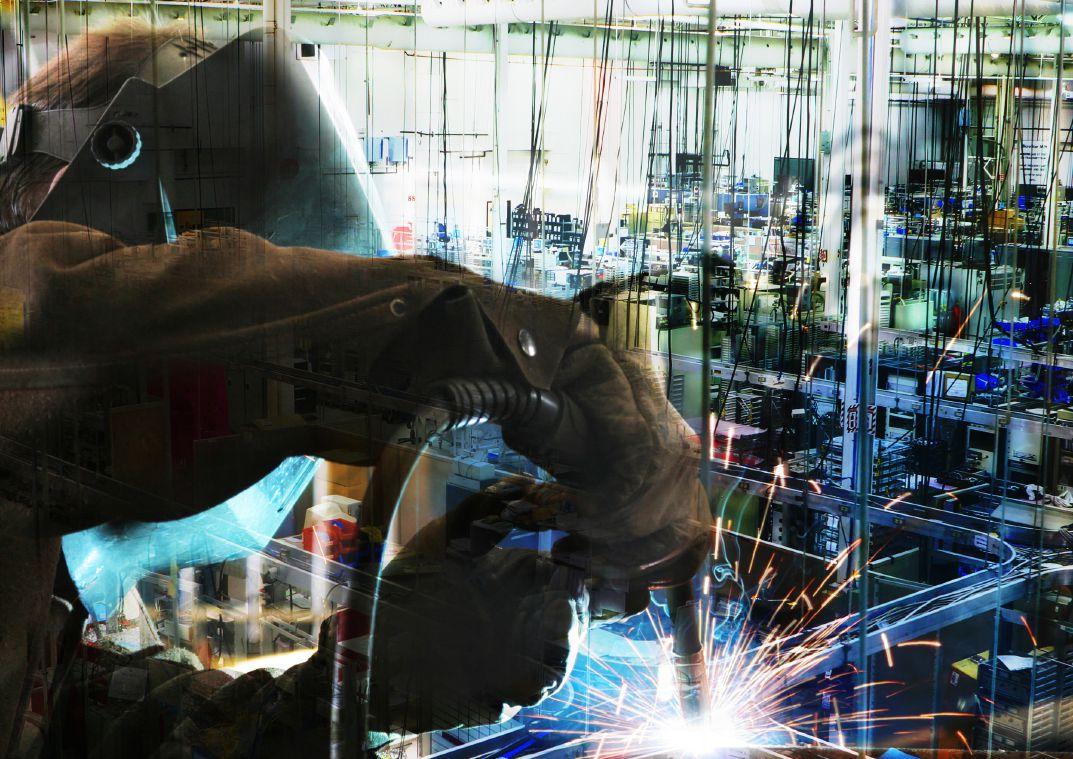
Electricity sector businesses like yours depend on talented tradespeople to thrive and grow. You can help build a skilled next-generation workforce by taking on a third- or fourth-year apprentice today. EHRC’s Destination Trade program makes it easy with funding of up to $5,000 for every placement.
at
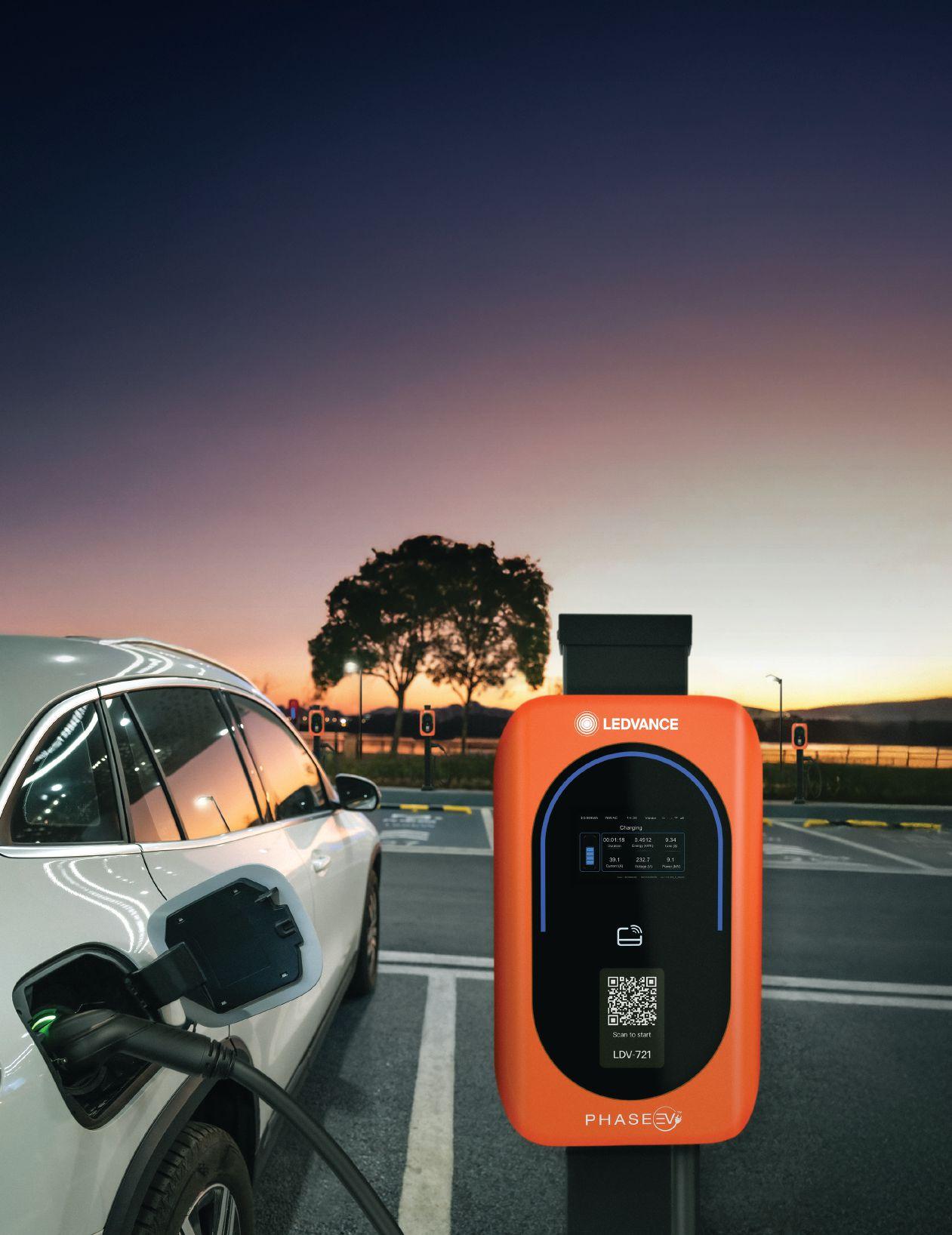
As Canada accelerates its EV infrastructure buildout, LEDVANCE brings a century of electrical expertise to a new frontier: commercial EV charging.
Introducing the PHASE EV™ Gen 2 Level 2
Commercial Charger — a smarter, more adaptable charging solution engineered for the demands of real-world installations in Canada’s toughest environments.
Backed by over 100 years of LEDVANCE reliability, this next-generation charger is built for real-world commercial environments and engineered to meet the demands of contractors, facility managers, and electrical distributors.
Whether you’re installing EV chargers at a multi-residential property, workplace, or fleet depot, the PHASE EV™ Gen 2 delivers up to 48A (11.5kW) of selectable charging power and features:
Rugged NEMA 4, IP65-rated housing for outdoor conditions down to -40°C
4.3-inch multilingual touchscreen (English, French, Spanish) WiFi, Ethernet, Bluetooth, and RFID standard Optional 4G, ISO 15118 Plug & Charge, and credit card reader CTEP certified and now available in Canada
The charger comes pre-configured for ChargeLab and supports both OCPP 1.6/2.0.1 platforms for seamless integration with today’s leading charge management systems.
Now Available Through Authorized Canadian Distributors

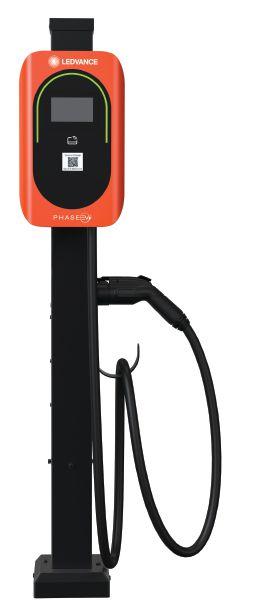

Hitachi and ABB collaborate on full battery dump truck /
BY EBMAG STAFF
Hitachi Construction Machinery Co. Ltd. commenced the technological feasibility trial of the world’s first* ultra-large, full battery rigidframe dump truck by an OEM, which it developed alongside its electrification partner ABB.
“Mining companies around the world are working to reduce emissions,” said Hitachi’s Eiji Fukunishi. “The battery dump truck represents the future, not only for the Hitachi Construction Machinery Group but for the mining industry as a whole [...]”
The dump truck is being put through its paces at First Quantum Minerals Ltd.’s Kansanshi
deep open-pit copper and gold mine in the Republic of Zambia.
The feasibility trial aims to verify the dump truck’s basic performance (e.g. travelling, turning, stopping) under actual operating loads, as well as battery performance.
The Kansanshi mine provides Hitachi with the infrastructure and facilities that are needed to test a full-battery dump truck, says the OEM, including overhead dynamic charging solutions and a variety of haul circuits in an actual operational mining environment.
it came together
The partnership between First Quantum and Hitachi Construction Machinery began 12 years
Battery dump truck onsite at First Quantum Minerals Ltd.’s Kansanshi deep open-pit copper and gold mine in Zambia.

ago through their collaborative development of trolley-assist technology.
Full battery rigid dump truck under testing.

“Thanks to this technology, we greatly improved the speed of ramp climbing. This reduced fuel consumption, extended engine life, and reduced CO2 emissions,” First Quantum’s mining operations manager Rees Magrath.
Hitachi began collaborating with ABB’s Traction division in June 2021 to create the fully electric dump truck for heavy-duty mining operations.
Utilizing ABB’s battery technology and DC/DC converters, existing Hitachi trucks can be transformed from diesel to fully electric operation. The trucks use a new onboard electric system that draws energy from the overhead trolley supply to directly power the motor while charging the battery energy storage system.
After undergoing in-factory testing, the prototype was shipped in January 2024 to the Kansanshi site.
“The project is not only helping to tackle the issues involved

in dump truck electrification, but is also contributing to enabling a low-carbon world through the reduction of greenhouse gas emissions,” said ABB Traction’s Fabiana Cavalcante. “We look forward to seeing the prototype prove its capability in the Zambian copper-gold mine.”
In Kansanshi
When operating on level ground, the truck runs on its internal battery. While travelling uphill, it draws power from the external trolley supply.
When running downhill, the regenerative braking system charges the battery, which reduces the charging load when the truck is connected to the trolley. This enables the truck to stay in continuous operation with no breaks for charging, thereby maintaining productivity.
In addition, limiting the battery volume reduces the battery weight as a percentage of the overall vehicle weight, helping to maximize the dump truck’s load capacity.

GABRIEL BONE
Technical training developer with Ontario’s Electrical Safety Authority
Welcome to the newest round of questions that test your knowledge of the CE Code-Part I. Answers will appear in the September 2025 edition of Electrical Business Magazine, and online at EBMag.com under Features.
QUESTION 1
What is the minimum class (tier) for grade-level inground enclosures supporting a designed vertical load of 15,000 lbf (pound-force)?
a) Class 2 b) Class 5 c) Class 8 d) Class 15
QUESTION 2
When a run of rigid conduit terminates in a flameproof “db” fitting in a Zone 1 location, how many tapered threads are required to be fully engaged with the fitting?
a) 1.2 b) 2 c) 4.5 d) 5
QUESTION 3
“The truck can move more quickly and efficiently. This allows us to reduce the use of diesel trucks and helps reduce carbon emissions. It’s an incredible system that’s really unique,” said chief mining engineer George Nzoma.
Mine maintenance manager Gregory Mwansa added that the truck also contributed to worker safety.
“It’s difficult for truck operators and workers in the area to sense danger because they’re always exposed to noise. But a full battery rigid dump truck has no engine, so workers can always hear even low-volume sounds. This lets them to work with greater peace of mind.”
“A full battery rigid dump truck is revolutionary for the entire industry,” Magrath continued. “I’m truly thrilled we can participate in this trial.”
* As of June 27, 2024, based on a survey conducted by Hitachi Construction Machinery of ultra-large dump trucks with a load capacity of 150 tons or more manufactured by OEMs.
For the installation of a wall-mounted dry-core, open-vented transformer, what is the minimum permissible air space between the Xfmr enclosure and the adjacent non-combustible wall?
a) 6.5 mm b) 50 mm c) 150 mm d) 300 mm
ANSWERS
Electrical Business, April 2025 ed.
QUESTION 1
If an enclosure is neither used in a hazardous location nor marked as per Table 65, where is it permitted to be used?
b) Indoors in ordinary locations. Rule 2-400(2)(a).
QUESTION 2
What is the IEC equivalent of a #8 AWG conductor?
d) 10 mm2. Rule 4-002(2), Table D18.
QUESTION 3
A heater control device may be installed 1 m to 500 mm from a shower stall entrance if it is:
a) Supplied by an extra-low-voltage Class 2 circuit. Rule 62-130(2)(b).
How did you do?
3 • Seasoned journeyman 1 • Apprentice 2 • Need refresher training 0 • Just here for fun!
BY TONY KOVAC
Even though our world cannot exist without them, I confess to feeling a little sorry for data centre operators after reading Eaton’s white paper “2025 Data Centre Progress Report”.
Authored by Rich Karpinski, principal analyst and channel lead for the 451 Research service of S&P Global Market Intelligence, the white paper lists numerous concerns that these enablers of the “Intelligence Age” face daily.
The Eaton white paper is based on a commissioned web survey conducted in March and April 2024. Respondents from a dozen or so countries were qualified based on knowledge of their organization’s adoption of digital transformation strategies. The sample size for the commercial data centre owners and operators in this study was 345.
The progress report includes data from S&P Global Market Intelligence and its 451 Research service, as well as Eaton’s Brightlayer Report 2024, “The evolution of digital transformation: adoption, execution and expan-
sion in the wake of AI”, with data collection and analysis by S&P Global Market Intelligence 451 Research.
In short, you could say that Karpinski’s analysis presents a pretty fair representation of what’s going on with data centres, and the challenges faced by their operators.
DC operators are asked to deploy new computing infrastructure in spaces ranging from the largest facilities to small “edge” locations. Whatever the site, they have to optimize that space while simultaneously addressing significant energy, power, and cooling requirements. Oh, and operators have to do all this against the backdrop of chasing ever-loftier sustainability goals, which often include the incorporation of renewable energy sources.
(I won’t even get into cybersecurity.)
In the white paper, Karpinski explores five trends that will transform data centres. For our purposes, we will focus on the areas where engineers and contractors can use their electrical intelligence to come to a DC operator’s rescue.

“The need to serve compute-heavy AI workloads has become job one for both commercial and enterprise data centres,” Karpinski writes, noting that AI workloads—particularly generative AI, or GenAI—present extremely high computational and storage requirements.
How high? According to the paper, the coming wave of accelerated computing is forecast to increase annual electricity demand from data centres to more than 280 TWh in 2024 in the U.S. alone! By 2028, this is expected to nearly double to 530 TWh.
Within the data centre itself, rack densities above 10 kW are prevalent and will continue to rise, with the largest proportion of respondents (35%) employing rack densities of 21-50 kW. The proportion of respondents with rack densities of more than 100

kW is projected to increase from 9% currently to 15% in five years.
Although data centres are among the world’s largest energy consumers, Karpinski notes this sector also has some of the most aggressive sustainability goals, with large DC operators like Google and Microsoft promising 100% use of renewable energy within the decade.
But then there’s that growing AI demand, which is not helping matters at all, as it creates additional power demands for operators. While compute capacity is driving decision-making in the moment, “medium- and long-term sustainability goals, such as reducing carbon footprint, increasing the use of renewables, and managing climate change risk, are a priority today and will likely remain so across the coming decades”.
And it’s no easy task striking a balance between the capacity
needs of today against long-term sustainability. According to Karpinski, it’s a tough challenge for even advanced DC operators.
“For instance, Google reported a 13% rise in carbon emissions in 2023, primarily attributed to increased data centre energy consumption, despite significant investments in clean energy,” he notes.
To address sustainability challenges, DCs are focusing on renewable energy sources, such as solar and wind, as well as improved energy storage to help mitigate renewables’ intermittency.
Meanwhile, operators are also relying on transmission and distribution upgrades to the grid. For example, major US investor-owned utilities have announced plans to spend nearly $400 billion on upgrades over the next five years to address data centre capacity demand and improve overall grid resiliency and efficiency.
Although data centres are among the world’s largest energy consumers, this sector also has some of the most aggressive sustainability goals.
Respondents noted the following as their energy/power-focused operational priorities:
41% Increase the use of renewable energy sources
37% Improve energy storage capabilities
30% Lower overall energy/ power costs
28% Achieve power usage effectiveness (PUE) targets
28% Turn energy/power management storage from cost to revenue centre
22% Operate an overall carbon-neutral facility
22% Leverage energy credits/ carbon offsets
17% Sell power back to the grid
16% Deploy microgrids
At the heart of these priorities are electrical engineers and contractors, who can play a vital role in designing and implementing the power infrastructure that helps DC operators meet their capacity and sustainability goals.
The data centre sector is expanding rapidly, and the need for skilled electrical professionals right alongside it. Those who can navigate power distribution challenges, integrate cutting-edge energy storage solutions, and implement sustainable practices will be invaluable partners.
From backup power systems to energy efficiency solutions and microgrid deployment, electrical expertise is critical. As operators move toward renewables, battery storage, and more intelligent power management, those with experience in these areas will find themselves in high demand.
BY TONY KOVAC

The Ontario government announced it is spending up to $285M to advance pre-development work for the proposed Ontario Pumped Storage Project, which would be developed by TC Energy in partnership with the Saugeen Ojibway Nation in the Municipality of Meaford.
The pre-development work includes the completion of a detailed cost estimate, and environmental assessments to determine the project’s feasibility.
The facility would function by pumping water from Georgian Bay up to a reservoir during periods of low electricity demand, then release the water back into the bay to generate electricity during periods of high demand.
If developed, the facility would co-locate on the existing Canadian Army’s 4th Canadian Division Training Centre.
Project background
In December 2024, Minister of Energy and Electrification Stephen Lecce directed Ontario’s Independent Electricity System Operator (IESO) to:
“[...] make all reasonable efforts to, and take all necessary steps to,
finalize and enter into a contract with TCE to enable TCE to recover eligible, prudently incurred expenses associated with the completion of pre-development work on the project [...]”
However, IESO initially recommended that the province not proceed with the Meaford PS project (nor the OPG/Northland Power Marmora project). In a report to then-Minister of Energy Todd Smith (September 2023), IESO stated that, under currently proposed cost structures:
“[...] the [PS] projects do not compare favourably to currently available alternatives, including battery storage or a portfolio of other non-emitting resources, and therefore neither [PS] project is able to provide net benefits to Ontario’s electricity system or ratepayers.”
In January 2024, Minister Smith noted that IESO’s evaluation:
“[...] did not include a valuation of other broader societal and economic benefits from these projects. There are also potential value and risk mitigation opportunities provided by domestically
sourced and constructed projects [...]”
In response, TC said that it and Saugeen Ojibway Nation would assist with the ministry’s evaluation of the project’s broader societal and economic benefits, and work to establish a potential longterm revenue framework for the project.
The province will make a final decision on the project after a detailed cost estimate. The project also remains subject to the approval of TC’s board of directors and Saugeen Ojibway Nation. Should the storage project proceed, it would be the largest of its kind in Canada, providing up to 1000 MW of electricity storage.
TC says it will be designed, engineered, and built by a domestic supply chain. It will create 1,000 unionized jobs during construction, and over 75% of the total materials and supplies will be provided by Ontario-based companies.
Construction is expected to begin in the latter part of this decade, and the project would be operational in the 2030s (subject to regulatory and corporate approvals).







BY ANTHONY CAPKUN
Support Ontario Youth (SOY) hosted its first Trades & Talent Summit in Mississauga, with the goal of connecting individuals with rewarding careers in the skilled trades.
(Special thanks to Melanie Winter and Angela Thomas for welcoming Electrical Business Magazine to the event!)
With 29 employers and partners in attendance at the Mississauga venue, the summit was purposely geared toward those exploring a career change or actively seeking job opportunities, and was open to everyone aged 18+.
(Among those partners was the Ontario Electrical League, which guided jobseekers who were interested in becoming electricians to visit OEL’s website and learn more about its contractor members.)
“Our first-ever Trades & Talent Summit was a success by all measures,” said SOY executive director Melanie Winter. “We connected hundreds of jobseekers with skilled trades employers who were looking to hire or expand their pool of candidates for future opportunities.”
The summit attracted roughly 200 jobseekers from a variety of ages and backgrounds, who met potential employers and connected with industry leaders, worked with experts to polish their resumés, and received advice from skilled trades professionals.
“A highlight of the day was an engaging and informative panel discussion featuring a diverse group of skilled trades professionals who offered valuable advice and insights into career pathways,” Winter added.
That panel discussion—“Building the future: navigating the evolving world of skilled trades”—featured the following professionals:
• Riley Chafe, licensed construction & maintenance electrician, SOY electrical mentor
• Noah Lebrun, 3rd-year industrial millwright apprentice
• Emily Pyke, automotive service technician, co-founder of Autocate
• Carly Ann Moore, beauty industry educator and mentor
• Peter Ciardulli, owner, Calia Hair
• Jill Cicchello, plumber, SFD coordinator at Enercare


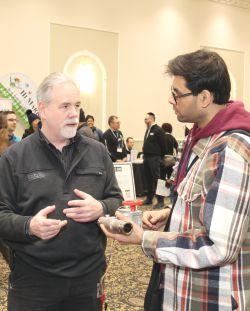

WCG Services manages Employment Ontario services in various regions across the province. For employers, WCG offers a pool of active jobseekers and can help you create, promote, and host hiring events.


Great interest at the Westlake table, where career-seekers learn how Westlake Housing & Infrastructure Products produces finished goods and materials in several segments, including compounds that are used in the manufacture of wire and cable.

An initiative of Support Ontario Youth, the free, one-day Tools in the Trades Boot Camps are designed to introduce participants to the skilled trades. The latest boot camp season saw 1,089 participants engage in hands-on training, explore career pathways for the skilled trades, and connect with industry professionals.

Catholic Community Services of York Region (CCSYR) helps employers connect with “qualified, interview-ready candidates” who have hands-on experience and certifications in the skilled trades.
Support Ontario Youth is a registered charity that identifies gaps in apprenticeship learning and training and helps those directly involved by supporting, mentoring, and guiding their efforts.
Employers who partner with SOY get support in managing apprentices and workforce development. They receive guidance through the apprentice registration process, sponsorship management, and assistance in sourcing jobready candidates. With a network of members across the Construction, Industrial, and Motive Power sectors, SOY connects businesses with talent so they can grow.

IN CANADA
bandngo.com
1-888-871-6573
sales@bandngo.com



DAN LEDUC
After seeing a demonstration at the Electrical Contractors Association of Ontario’s annual conference, it became clear to me that power-over-Ethernet (PoE) technology is changing the game in construction projects.
In addition to its flexibility, PoE’s rising popularity in Canada is closely tied to the country’s sustainability goals. With a national commitment toward achieving net-zero emissions by 2050, PoE-powered systems are embraced as energy-efficient solutions.
By allowing both power and data to travel through a single Ethernet cable, PoE simplifies installations and can support numerous building systems, such as smart lighting, HVAC controls, and IP cameras.
While its advantages are clear, this low-voltage technology also introduces legal and regulatory challenges that developers, contractors, and others must navigate to stay compliant and minimize liability.
PoE typically operates below 60 VDC, meaning it doesn’t require the same level of oversight as higher-voltage systems. In many cases, the work can be handled by certified network technicians or installers—not licensed electricians. While this flexibility can save on costs, it also creates a potential grey area when it comes to compliance, liability and, quite possibly, union relevancy.
Regulations vary across Canadian jurisdictions. Some require licensed electricians for certain installations, particularly those involving high-voltage systems. Additionally, compliance with fire safety standards under the CE Code (as adopted by your jurisdiction) remains mandatory, particularly when using cables in plenum spaces.
These systems can help developers achieve certifications like LEED or BOMA BEST, but overstating the sustainability benefits of a PoE system—or failing to deliver on claims—can lead to reputational damage and potential legal issues.
Whether you’re a developer, contractor, or installer, it is crucial to clearly define roles and responsibilities around compliance, warranties, and liability. For example:
• Who is responsible if an installation fails because it wasn’t handled by a licensed electrician?
• What happens when a cybersecurity breach occurs?
• Does your insurance policy cover risks specific to PoE technology?
Addressing these questions early can help prevent disputes and protect all parties involved.
Taking a proactive approach toward PoE installations can help mitigate risks. First, ensure you’re familiar with your AHJ’s regulations and codes for low-voltage systems. While licensed electricians may not always be required, using certified installers is critical to avoid compliance issues.
Second, cybersecurity is not just an IT concern, but also a legal one, so take this very seriously. Third, digitally document everything. Keeping detailed records of installation practices, compliance checks, and certifications can provide a strong defence in the event of disputes or claims.
Finally, carefully read your contracts to ensure the risk profile matches what you understand it to be.
Despite its unique challenges around contracting, compliance, and cybersecurity, PoE technology holds tremendous potential. With thoughtful planning and the right safeguards, PoE can be a game changer for your electrical contracting business and Canada’s construction sector.
This column is not legal advice, nor should it be taken as such
Dan Leduc is a partner at Soloway Wright LLP, and specializes in construction law. He is always happy to take on new clients from anywhere in Canada, and can be reached at dleduc@solowaywright.com.
The NECA Show National Electrical Contractors Association September 12-15, Chicago, Ill. necanet.org
CANEW: Canadian Airports National Electrical Workshop Canadian Airports Electrical Association (CAEA) September 21-26, Edmonton canew.ca
ECAO Annual Industry Conference Electrical Contractors Association of Ontario September 22-26, Whistler, B.C. ecao.org
Energy Storage Canada Annual Conference September 25-26, Toronto energystoragecanada.org
OCS AGM & Conference Ontario Construction Secretariat Sept. 29-Oct. 1, Blue Mountain, Ont. iciconstruction.com
NETCO Annual Training Conference National Electrical Trade Council October 1-2, Cardigan, P.E.I. netco.org
Electric Mobility Canada National Conference October 1-3, Vancouver evve.emc-mec.ca
Electricity Transformation Canada Canadian Renewable Energy Assoc. October 6-8, Toronto electricity-transformation.ca
AD Electrical North American Meeting Affiliated Distributors October 27-30, Chicago, Ill. adhq.com
CIPHEX + Electrical Learning Expo West BCEA, AEA, CIPH November 5-6, Vancouver ciphexwest.ca
Got an event to share? Email the editor at acapkun@ebmag.com. Meantime, scroll through Electrical Business Magazine’s online industry calendar at ebmag.com/events for direct links to these events (and others).

Frank Magisano has been promoted to the position of vice-president and general manager of Hubbell Canada, replacing Kevin Mallory, who retired in April. Magisano joined the Hubbell team in 2001, says the company, “and has since demonstrated exceptional leadership and expertise across various departments [...]”.
Source: SUPPLIED,

Desiree Grace has joined Mersen Electrical Power (EP) as vice-president of sales and customer care, Americas. She started her career at WESCO, and has held sales leadership roles at manufacturers such as Panduit and Eaton, and executive positions with Flex Wind, CEMBRE, and Anamet. Grace reports to Ferran Sacrest, vice-president, Global Sales and Customer Care.
Source: Supplied




leadership team, reporting to Leblanc. John H. Jenner, Electrozad’s chief financial and chief operations officer, has retired. Also a Sonepar company, Electrozad is an electrical distributor in Southwestern Ontario with locations in Chatham, Sarnia, Windsor, and London.
Source: SONEPAR CANADA

Hammond Power Solutions has appointed Linda Nadeau Sanford to the position of sales manager, Western Region. She previously served as sales manager for the Greater Toronto Area (East).
Source: Supplied

Lumen president Serge Leblanc has been appointed interim president of Sonepar Canada—in addition to his role at Lumen—until a successor to George McClean is named. Leblanc has over 30 years of experience in the electrical industry. He joined Lumen in 1997, and was appointed president in October 2011. Sonepar has promoted Rob Thibeault to president of Robertson Electric Wholesale, as Rick Campbell transitions to the newly created position of executive advisor at Sonepar Canada, where he will assist on key projects across the company while providing transitional leadership at Robertson. Thibeault becomes a member of Sonepar’s executive
Yavor Kolarov, who joined Eiko Global LLC in 2024 to serve as president and chief revenue officer, has been promoted to CEO. Company founder Gary Withers will continue to serve as chair of the board of managers.
Source: Supplied

Mike Chowen (photo) has joined Jebco Agencies and will assume majority ownership of the business in January 2026 from current president Dave Kelly, who will retire early next year. Jebco is an electrical manufacturers rep firm serving Saskatchewan, Manitoba, and northwestern Ontario. Grant Schmidt will continue as a partner in Jebco.
Source: Supplied

Three employees of SLS Group Industries Inc. Nitin Naidu, Ryan Cattermole, and Douglas McDonald have moved into ownership positions
at the British Columbia-based lighting sales agency. “These individuals have consistently demonstrated their ability to drive results and inspire teams,” said GM and co-owner Brian Poole.
Source: Supplied

Mac’s II Agencies has expanded its lighting division with the addition of Jamie Capell as sales manager for lighting specification. Mac’s II Agencies is a manufacturers’ representative agency serving British Columbia and Yukon.
Source: Supplied

Charlotte Mitha will become BC Hydro’s next president & CEO effective August 1, succeeding Chris O’Riley, who is retiring after 35 years with the company. A registered professional engineer with Engineers and Geoscientists BC, she worked as a mechanical engineer on hydroelectric generation and infrastructure projects in British Columbia before joining BC Hydro. Last fall, she was recognized with Electricity Canada’s Women in Electricity award (2024).
Source: Supplied
Chuck Cartmill—founder and CEO of LED Roadway Lighting/Liveable Cities—has retired. Ken Cartmill and Dave Scott have taken over as coCEOs. “I have complete confidence in their ability to lead this company into an exciting new chapter,” said Cartmill.

Catalyst Sales & Marketing, a manufacturer rep agency serving Atlantic Canada, welcomed Bronte MacLeod to the team as customer experience specialist, where she will serve as the first point of contact for customer enquiries.
Source: Supplied
We’re limited by space here, but have plenty of room online! Read the news behind the news Visit EBMag.com and click “News”.

We offer multiple solutions to more effectively seal around pipes, conduits and cables that reduce installation time and workmanship errors.

Whether you need to meet CEC codes for sealing conduit/raceways, increase electrical reliability, storm hardening of your system, or manage how cables and pipes enter structures, we have the solution for you.


My Measurement Assistant+ is an AI-powered solution for maintaining and troubleshooting measurement devices. Leveraging GenAI, cloud computing, and augmented reality, the application collects data from multiple sources to provide a single access point for information, diagnostics, and remote support.
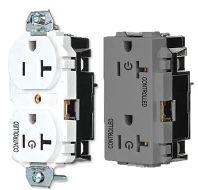
The receptacles feature patented spring terminals that improve installation time by 80%, says Hubbell, eliminating the need for screwdrivers or additional tools. The devices are designed to reduce unnecessary electricity consumption by cutting off power at predetermined times.

with open network management platforms. It provides both wall and pedestal mounting options—including back-to-back and side-byside configurations.

Suitable for both commercial and residential applications, Arlington’s non-metallic CableAble support brackets are designed to carry cable or conduit, power or low-voltage wiring in plenum (NEC 300.22[c]) or non-plenum ceiling environments. The 4-hole and 8-hole brackets mount horizontally or vertically to wood or steel studs and unistrut, and horizontally to all threaded rod and beam clamps.

Ledvance’s next-generation commercial charger includes a suite of upgrades, output settings that range from 8 A to 48 A (80 A expected later), and introduces modular smart features, multilingual touchscreen controls, and compatibility

Ranger Design offers a purpose-built upfit for Chrysler Pacifica, Voyager, SourceS: Supplied
and Grand Caravan, transforming these platforms into fully equipped mobile workspaces. Depending on the vehicle type, upfit components may include aluminum contoured partitions, drill-free e-floor, rear window grills, and interior ladder holder.

This 42-in. outdoor lighting solution features three selectable wattages, delivers up to 3360 lumens with a full 360° beam angle, and offers selectable colour temperatures. The bollard features an aluminum body and polycarbonate lens for durability, and is rated for 50,000 hours. A built-in 10-kV surge protector and photocell On/Off functionality improve energy efficiency while supporting automated operation.
Fluke 283 DMM and a283 FC for solar PV

The 283 FC solar digital multimeter and a283 FC True-RMS wireless current clamp help you safely test individual panels, strings, or inverters in a utility-scale solar PV array. With the Fluke 283 FC DMM and a283 FC wireless current clamp, technicians can measure
voltage and current simultaneously, and automatically calculate VA power. This feature eliminates the need to change the measurement setup.

These junction boxes by Ipex are designed for durability and reliability in indoor and outdoor electrical applications. Moulded from PVC, the boxes resist impact, water, chemicals, and corrosion. Both products feature patent-pending integrated gaskets, non-metallic fasteners, embossed gridlines, and mounting feet to simplify installation.

Intended for 20×65-mm fuses, the fuse holders promise advanced safety and protection for high-amperage, utility-scale DC distribution applications. They are IP20-rated for finger-safe operation, and are well-suited to cabling, bus, and auxiliary circuits, as well as EV charging, critical power, and UPS protection.
We’re limited by space here, but have plenty of room online! Check out more products and solutions at EBMag.com, under “Products”.
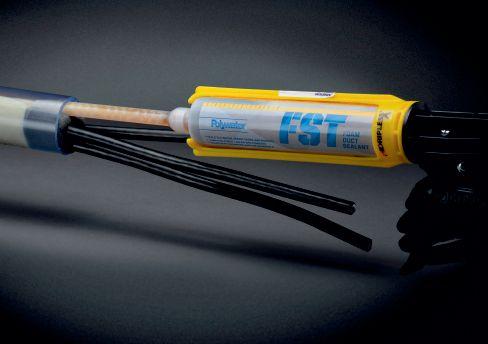

• Holds 22 ft. (6.7 m) of water head pressure and up to 90 ft. (27m) surges
• Rodent-resistant formula with a bittering agent additive
• Can seal conduits of all sizes and is re-enterable • Use

DIANA MADILL
Due to government incentives, a growing renter population, rising rents and other factors, we see that developers are increasingly prioritizing the construction of high-rise apartment buildings.
An RLB Crane Index* report shows that Ontario’s operating tower crane count is increasing, with the City of Toronto currently holding the top spot of the 14 cities surveyed in Canada and the U.S.
With so many tall buildings being erected, it’s important to remember that conductors—whether installed in a raceway or contained in an armoured or sheathed cable assembly—require special consideration for their support when run vertically over extended distances.
There are distinct differences in the acceptable means of supporting these conductors, which are determined by the installation method and described in Canadian Electrical Code-Part I, Rule 12-120 “Supporting of conductors”.
Fun fact: the earliest version of Rule 12-120 appeared in the first edition of the Canadian Electrical Code. In 1927, Rule 503(p) addressed vertical conductor support in metal conduit work by specifying support intervals based on the size of the conductor.
Today, this rule continues to provide support requirements to ensure that vertical conductors will not slip due to their weight under gravity and experience damage, which can be caused by either inadequate supporting means or
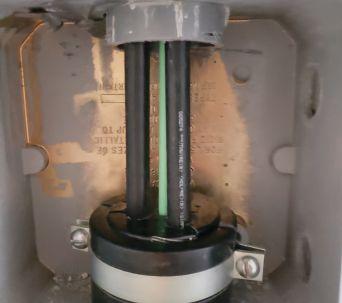
Wedge-type vertical conductor support within an access box.
by overhanging the conductor on the edges of equipment or fittings.
Rule 12-120 also ensures equipment and terminations will not be subjected to damaging strain imposed by the conductor’s weight.
For raceway installations, Table 21 prescribes the acceptable support intervals based on the conductor size and material. Wedge-type grips (Figure 1) are one acceptable and commonly employed means for complying with code requirements, but there are other acceptable solutions that are approved for the purpose.
The support means must maintain the continuity of the raceway, be approved for use in Canada, be installed in accordance with the manufacturer’s instructions, and be independent of terminations. It is not permitted to
support conductors in raceways by means of periodic offset bends or by any ratio of horizontal to vertical distances (which are only recognized for cable installations).
For armoured or sheathed cable installations, Table 21 again determines acceptable intervals for the internal conductor assembly supports. Like conductors in raceways, the support may be provided using approved manufactured products, but additional support options are available. One support method involves incorporating the equivalent of not less than the equivalent of a 90º bend at the specified interval found in Table 21.
Rule 12-120 also provides for two other methods, neither of which rely on specific intervals for the supporting means. The first option is to include a horizontal run of the cable that is at least equal in length to the vertical run. The second is to use a cable specifically built for vertical runs i.e. its inner conductor core has been designed to prevent slippage from the armour or sheath.
Planning the support of vertical conductor runs to ensure they meet code requirements is of paramount importance at the design stage of a project. This will ensure that any necessary enclosures housing the supporting means remain accessible (as required by Rule 12-3014), and that the support method can be implemented within the specific building construction.
Always consult your AHJ for more specific interpretations
* Crane Index North America, Q1 2025, Rider Levett Bucknall.
Diana Madill is a Red Seal Electrician (309A), Master Electrician, and Canadian Certified Electrical Inspector, and currently serves as a technical advisor at Ontario’s Electrical Safety Authority. She is a member of several CE Code-Part I Section committees, as well as CSA Z32. Diana also sits on the Ontario Provincial Code Committee and is a member of the IAEI-Ontario Section board.





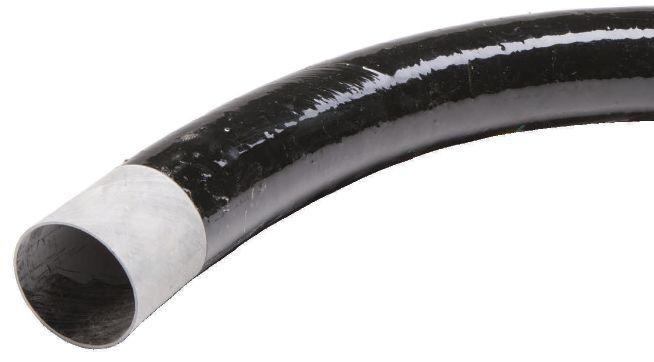
No burn-through eliminates elbow repairs
Light weight facilitates a smooth, safe installation
Fault resistance makes repairing cables easy
Durable and corrosion-resistant for lower total cost of ownership
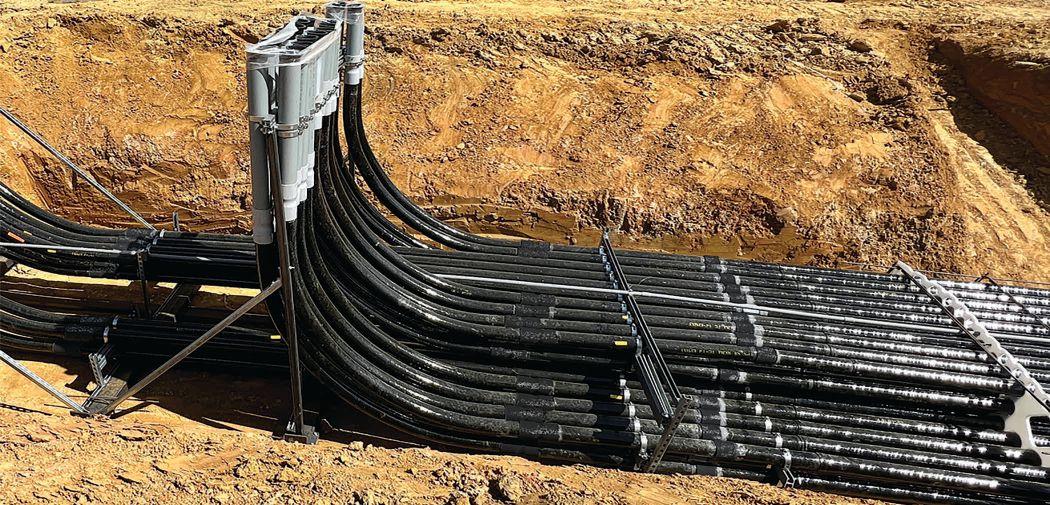

LEARN MORE ABOUT CSA LISTED FIBERGLASS CONDUIT
